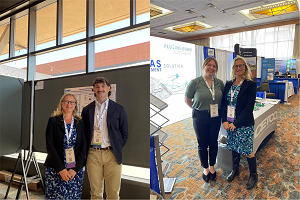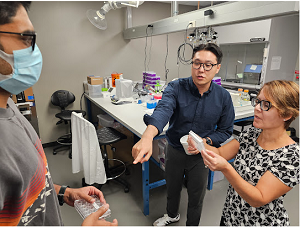Science Leadership
SRP staff congratulates SRP Health Scientist Brittany Trottier, Ph.D., for successfully defending her Ph.D. dissertation. Trottier completed her doctorate through the Gillings School of Global Public Health at the University of North Carolina at Chapel Hill.
In fall 2023, SRP hosted a Risk e-Learning Webinar Series titled Tools for PFAS Site Characterization. Leading the conversation on PFAS, the first and second sessions of this series were among the most watched webinars on CLU-IN in 2024, each receiving 2,051 and 1,202 online replays, respectively.
This November, SRP hosted another Risk eLearning Webinar Series aimed at advancing environmental health research with artificial intelligence (AI) and machine learning (ML). Session one explored AI and ML approaches to understanding chemical exposures and effects on human health; session two discussed AI and ML applications to contaminant sensing and remediation; and session three investigated how AI and ML can optimize models and analyze mass spectrometry and microscopy data.

Left: Henry and Stackey. Right: Henry and Dickman. (Photos courtesy of Heather Henry)
In observance of Lead Poisoning Prevention Week and Children’s Environmental Health Month, SRP hosted Virtual Technology Fair, at which Small Business Innovation Research grant recipients presented about their innovative technologies for lead detection and treatment. SRP Health Scientist Administrator Heather Henry, Ph.D., moderated the event.
Henry also recently attended the Remediation Technology & Emerging Contaminants Summit. The event featured presentations by Nirupam Aich, Ph.D., a researcher from the University of Nebraska, and Chris Olivares, Ph.D., a former trainee from the University of Arizona. Additionally, Rebecca Dickman, Ph.D., a former trainee from the State University of New York at Buffalo, showcased a new remediation technology, while Justin Stackey, a trainee from the University of Rhode Island, presented a poster.

From left to right, doctoral student Rahul Cheurki, postdoctoral fellow SungJin Kim, Ph.D., and Carlin. (Photo courtesy of Texas A&M)
SRP Health Scientist Administrator Danielle Carlin, Ph.D., visited the Texas A&M University SRP Center in October. Project leaders gave presentations about their work, and Carlin toured various laboratories. She also visited the center’s “Igloo,” where Galen Newman, Ph.D., conducts disaster simulations, and the mobile van used by Natalie Johnson, Ph.D., for pollution monitoring.
Several SRP researchers were featured in NIEHS Stories of Success and Grantee Highlights. The stories explore the scientists’ background, research, and future goals.
- Rebecca Fry, Ph.D., director of the University of North Carolina at Chapel Hill SRP center, shared how she works from cellular to societal levels to protect children and pregnant women from environmental harms.
- Jennifer Kay, Ph.D., a research scientist at Silent Spring Institute, explained how her training at the Massachusetts Institute of Technology SRP Center prepared her for a new line of research investigating DNA damage, hormonal signaling, and breast cancer.
- Stephania Cormier, Ph.D., director of the Louisiana State University SRP Center, described how community engagement is advancing our understanding of air pollution and its impacts on infants.
- Nancy Cardona-Cordero, Dr.P.H., a former Northeastern University SRP Center trainee, shared about her journey from a trainee to a community-engaged scientist focused on understanding how climate change influences cancer outcomes.
Dibakar Bhattacharyya, Ph.D., of the University of Kentucky SRP Center was named a Fellow of the National Academy of Inventors. Bhattacharyya was recognized for his longstanding spirit of innovation and his drive to see his work make a positive impact in society.
A recently updated Public Health Impact Story explains how SRP is leading national strategies to reduce exposures to PFAS, by improving drinking water advisories, informing drinking water regulations, closing clinical research gaps.
Following an U.S. Department of Agriculture workshop about reducing exposure to toxic metals in food, Om Parkash, Ph.D., and Jason White, Ph.D., recently published key findings, including the current state of science, critical research gaps, and safety recommendations. The workshop was part of the Closer to Zero initiative, which aims to mitigate dietary exposure to hazardous elements.
to Top



